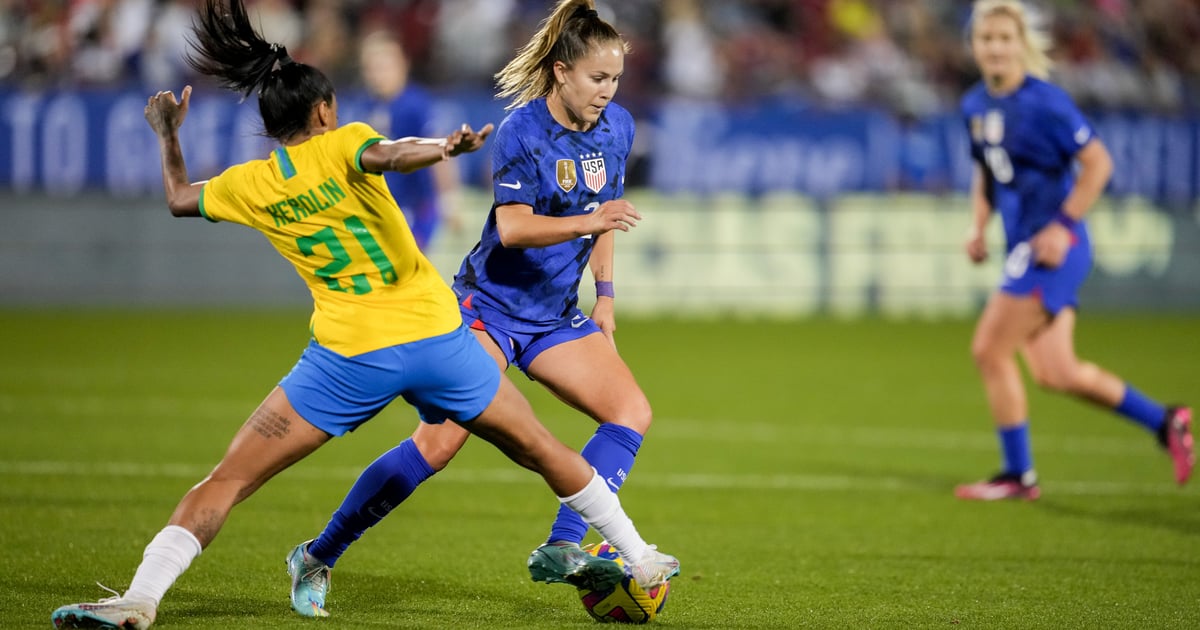
If you’re a long-time soccer fan, the 2023 FIFA World Cup is a big deal for you, and you probably could have written this article yourself. If you’re still pretty new to soccer — the US women’s national team has brought in a lot of new fans these past few years — it’s a good time to brush up on your knowledge, starting with how the scoring works.
To some, the way a game (even in an international tournament) can end up in a tie is one of the quirks of soccer — doesn’t someone need to win? Not always, but the rules can vary a little, depending on how far along it is in the tournament and which tournament is being played. Here’s everything you need to know about whether soccer games can end in a tie, including at the upcoming World Cup.
Can Soccer Games End in a Tie?
In most circumstances, a soccer game can end in a tie. If the game reaches the end of regular play (including any additional time the referee adds on to compensate for pauses in game play due to injuries, for example) and the score is tied, the game simply ends.
There is usually a points and ranking system, and each team is given a certain amount of points for wins or ties, with goal differential and goals scored acting as tiebreakers in the standings. However, this isn’t the case when it comes to a tournament where one team has to win it all.
How Do Ties in Soccer Work During the World Cup?
During the World Cup, the first stage of competition is the group stage, when teams play to accumulate points, and where ties are permitted. Teams are pre-sorted into eight groups of four teams, and teams play each other round-robin-style within each group, so every potential matchup between members of a particular group happens. According to current FIFA regulations, teams will get points for the outcome of each match: three points for a win, one for a tie, and zero for a loss.
From there, the points are added up, and the top two teams in each of the eight groups advances to the “round of 16.” Teams are assigned their opponents according to a specific, predetermined formula in the FIFA rules (i.e., the winner from Group A will be assigned to play the runner-up from Group C, and so on). At this point, the “knockout” stages begin, where a single loss removes a team from competition. Because a team needs to win in order to move forward in the tournament, the teams will attempt to break a tie by playing two additional periods of 15 minutes each, with a five-minute break before extra time and a one-minute “drinks break” between periods.
So what happens if there’s still a tie after those 30 minutes? That’s when the match goes into the penalty shoot-out phase, per The International Football Association Board (IFAB). Five players from each side are selected to take shots from the penalty-kick spot. Once every player has taken a shot (or once one team scores enough goals that it’s mathematically impossible for their opponents to tie or outscore them), the team with the most goals wins. If both teams score the same amount of goals at the end of that first set, teams will continue to kick one shot each until the tie ends — this is known as “sudden death.”
How Do Ties in Soccer Work During the Olympics?
Olympic tournaments handle ties pretty much the same way that the World Cup does. The Olympics, like the World Cup, begin with the group stage, where teams — sorted previously into three groups of four teams in the women’s tournament and four groups of four teams in the men’s — play each other. Each team gets three points for a win and zero for a loss, but if they tie, each team gets a point.
Once every matchup has happened, the points are tallied, and the top two teams in each group advance to the quarterfinal stage, along with, on the women’s side, the top two third-place finishers. If two or more teams have the same amount of points when the group stage ends, there is a whole set of slightly complicated criteria to break the deadlock — including goal differential.
After the group stage ends, as with the World Cup, ties at the end of regulation time will incur two, 15-minute additional periods. At the end of those two periods, the highest scoring team wins, or a shootout determines the winner. Once a team loses, it’s out of the tournament, with the only exception being the semifinals; the losers of the two semifinal matches go head-to-head to determine the third-place finisher.
Don’t Ties Make Soccer Games Boring?
Not at all! Soccer games that end in a tie are often just as tense and competitive as the ones that don’t. The very fact that they end in a tie often means that the teams are unusually well-matched and playing great on both offense and defense, rather than a clear imbalance of talent or power.
One of the most intense World Cup matches in recent history actually ended in a tie. Back in 2018, the men’s teams from Portugal and Spain faced off in an early-round match that ultimately ended in a 3-3 tie but was hailed as one of the greatest World Cup matches ever. If there are any ties in this year’s World Cup, we hope they’re just as thrilling!
